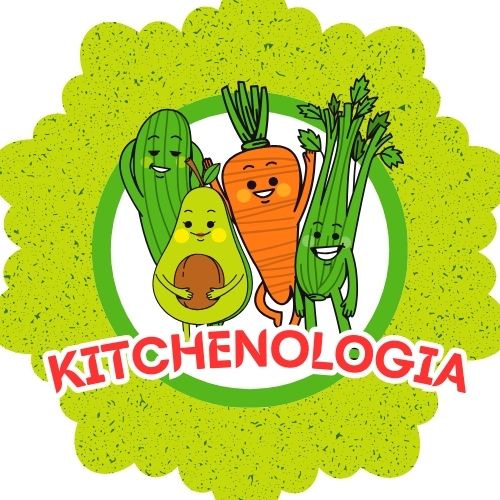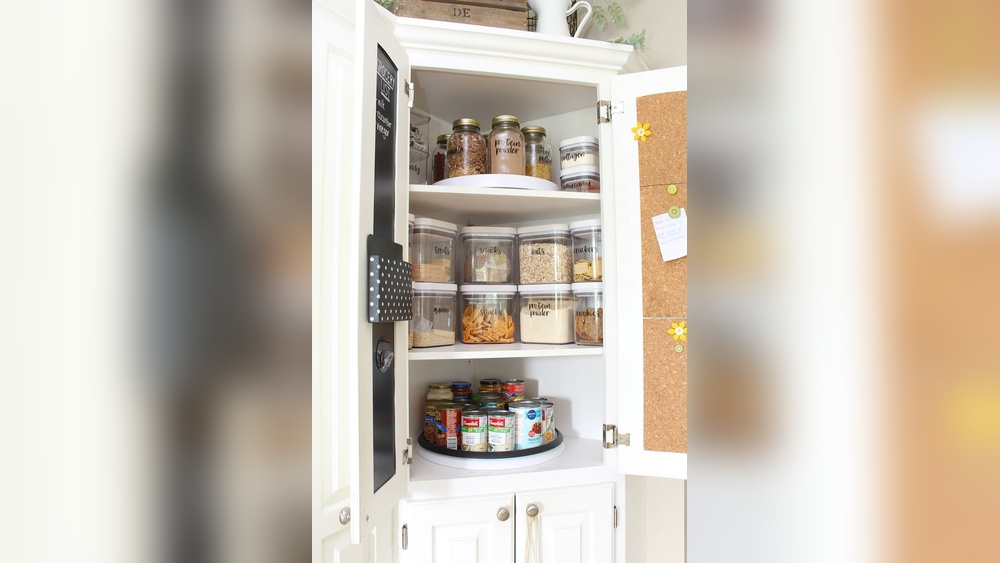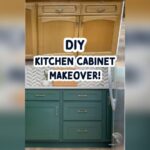Are your kitchen cabinets a source of daily frustration? You’re not alone.
When cabinets are cluttered or poorly arranged, finding what you need can feel like a constant struggle. But imagine opening your cabinets and instantly spotting exactly what you want—no digging, no mess. Organizing your kitchen cabinets effectively can transform your cooking experience, save you time, and even reduce stress.
You’ll discover simple, practical steps to organize your cabinets like a pro. Ready to turn your kitchen chaos into calm? Let’s dive in and make your cabinets work for you.
Cabinet Zones
Cooking Area Storage should be close to the stove and oven. Keep pots, pans, and lids in this spot. Store spices and oils nearby for quick use. Use drawer dividers for cooking tools like spatulas and whisks.
Cleaning Supplies Spot goes under the sink. Place dish soap, sponges, and cleaning sprays here. Use small bins to group similar items. Avoid storing food here to keep it safe.
Food and Pantry Sections work best with shelves or pull-out drawers. Group canned goods, snacks, and baking supplies separately. Label containers to find items fast. Keep heavy items on lower shelves for safety.
Utensils and Gadgets Placement needs easy access near prep areas. Use drawer organizers for forks, knives, and spoons. Store small appliances like blenders or mixers in upper cabinets. Keep less-used gadgets in higher or less accessible spots.
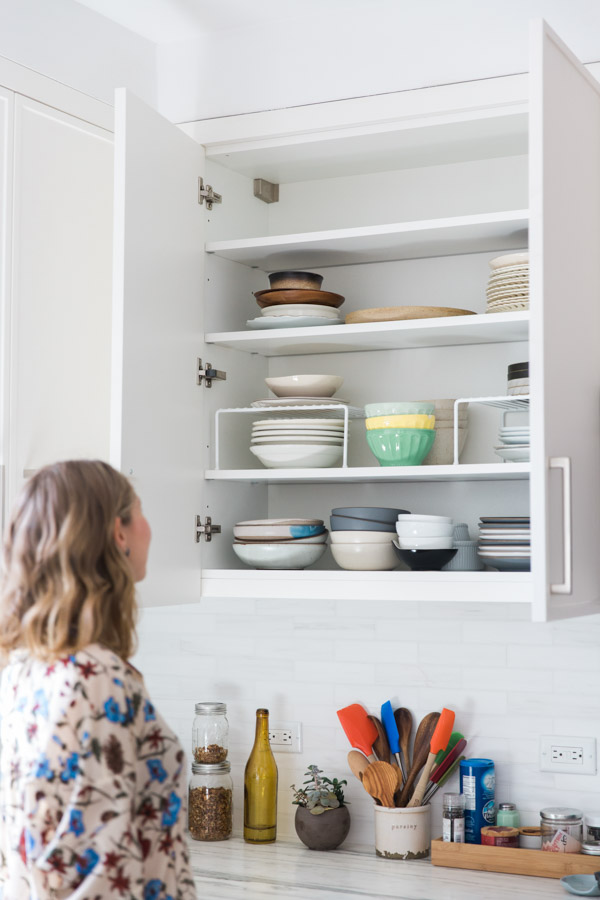
Declutter First
Start by removing expired items from your kitchen cabinets. Check food packages and throw away anything past its date. This helps clear space and keeps your kitchen safe.
Next, discard damaged dishes. Broken plates, chipped cups, and cracked bowls should be tossed to avoid accidents. Keep only items in good condition.
Sort food storage containers by size and type. Match lids with containers and throw away those without lids. Stack containers neatly to save space and find them easily.
Use Vertical Space
Install shelving inserts to create extra layers inside your cabinets. This helps store more items without stacking too high. Use adjustable shelves to fit different sizes of dishes and containers.
Stack items vertically to save space and make things easier to find. Place plates, cutting boards, or baking sheets upright like books. This keeps them neat and prevents damage.
Utilize door interiors by adding hooks or small racks. Store spices, lids, or cleaning supplies here. This frees up shelf space and keeps small items handy.
Group Similar Items
Keep stick like items together to find things fast. Group all spices in one basket. Place baking supplies in a bin. This way, everything is neat and easy to reach.
Use bins and baskets to hold small or loose items. They stop clutter and make cleaning simple. Clear bins help see what is inside at a glance.
Create themed sections for better order. Put all breakfast foods in one cabinet. Store pots and pans near the stove. This saves time when cooking.
Optimize Accessibility
Frequently used items should be placed at the front of cabinets. This makes grabbing them quick and easy during cooking. Keep things like plates, glasses, and daily spices where you can see them.
Store rarely used items on higher shelves or in the back. These could be holiday dishes, special cookware, or extra supplies. This saves space and keeps the main area tidy.
Pull-out racks help use deep cabinet space well. They allow you to slide out items without moving everything else. This keeps things organized and easy to reach.
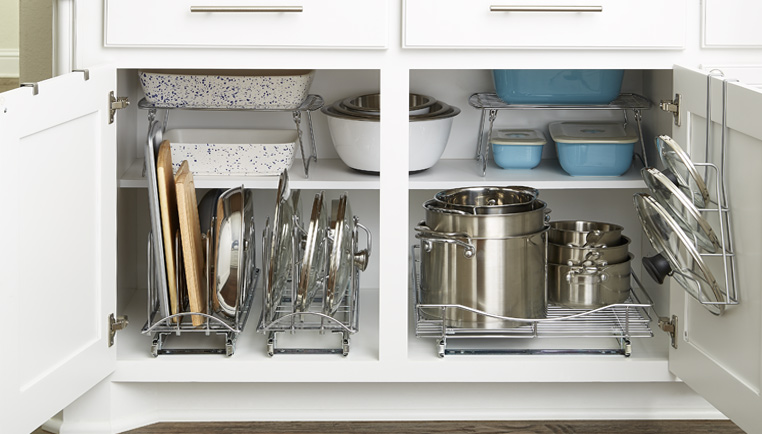
Specialized Organizers
Spice racks keep your spices visible and easy to reach. They save space and stop bottles from tipping over. You can use wall-mounted racks or pull-out drawers.
Drawer dividers create sections inside drawers. They help separate utensils, gadgets, and small tools. This makes everything easy to find and keeps drawers neat.
Vertical pan storage holds pans and lids upright. This method saves space and protects pans from scratches. Use dividers or racks designed for vertical storage.
Maintain Order
First In, First Out Method helps keep food fresh and avoids waste. Place new items behind older ones. Use older products first. This system saves money and space.
Regular Cabinet Audits mean checking your cabinets often. Remove expired or unused items. Clean shelves and reorganize. This keeps your kitchen tidy and safe.
Quick Daily Tidying takes just minutes each day. Put things back after use. Wipe spills quickly. Small efforts keep cabinets neat and easy to use.
Color And Style Tips
Avoid colors that feel old or too bright. Shades like avocado green or mustard yellow can make kitchens look outdated. Instead, choose timeless neutrals such as white, beige, gray, or soft taupe. These colors create a clean and calm look that lasts for years.
Try to match cabinet colors with your kitchen’s walls, countertops, and appliances. This makes the space look coordinated and neat. For example, white cabinets go well with dark countertops and stainless steel appliances. Soft gray cabinets can pair nicely with wooden floors or shelves.
:strip_icc()/kitchen-pantry-snacks-c2bb5c24-7b13dec53fc446c8ad1ae36763639f30.jpg)
Frequently Asked Questions
How Do You Decide Where To Put Things In Kitchen Cabinets?
Place frequently used items within easy reach, near work areas. Store rarely used items on higher or back shelves. Group similar items together. Use cabinet doors for extra storage. Organize based on cooking flow to enhance efficiency.
How Are Kitchen Cabinets Supposed To Be Organized?
Organize kitchen cabinets by grouping similar items together. Store daily-use items within easy reach. Place cookware near the stove. Use cabinet doors for extra storage. Keep less-used items on higher shelves or back of cabinets. Use organizers to maximize space and maintain order.
What Kitchen Cabinet Color Is Outdated?
Outdated kitchen cabinet colors include navy, cherry wood, mustard yellow, and country red. These shades now appear dated and overly themed. Choose softer neutrals, natural woods, or muted rich tones for a timeless, modern look.
What Are The 9 Steps In Organizing A Kitchen Cabinet?
The 9 steps to organize a kitchen cabinet are: declutter, group similar items, clean shelves, use organizers, store frequently used items upfront, label containers, maximize vertical space, nest smaller items, and maintain regularly.
Conclusion
Organizing kitchen cabinets helps save time and reduces stress. Place daily-use items within easy reach. Store less-used items on higher or back shelves. Use cabinet doors for extra storage space. Group similar items together for quick access. Regularly declutter to keep cabinets tidy.
A well-organized kitchen makes cooking more enjoyable. Small changes can create big differences. Start organizing today for a cleaner kitchen tomorrow.

Yes, working as , Food Blogger and Product Reviewer for last 6 years. Here you will get amazing deals for Smart kitchen products. I am your best source for the latest update in cooking trends. I provide insightful articles, reviews, and analysis on cutting-edge kitchen gadget. My mission is to empower readers with the knowledge they need to stay ahead in a rapidly evolving coking world. Join me as we explore the future of food technology and how it shapes our lives today and tomorrow.
